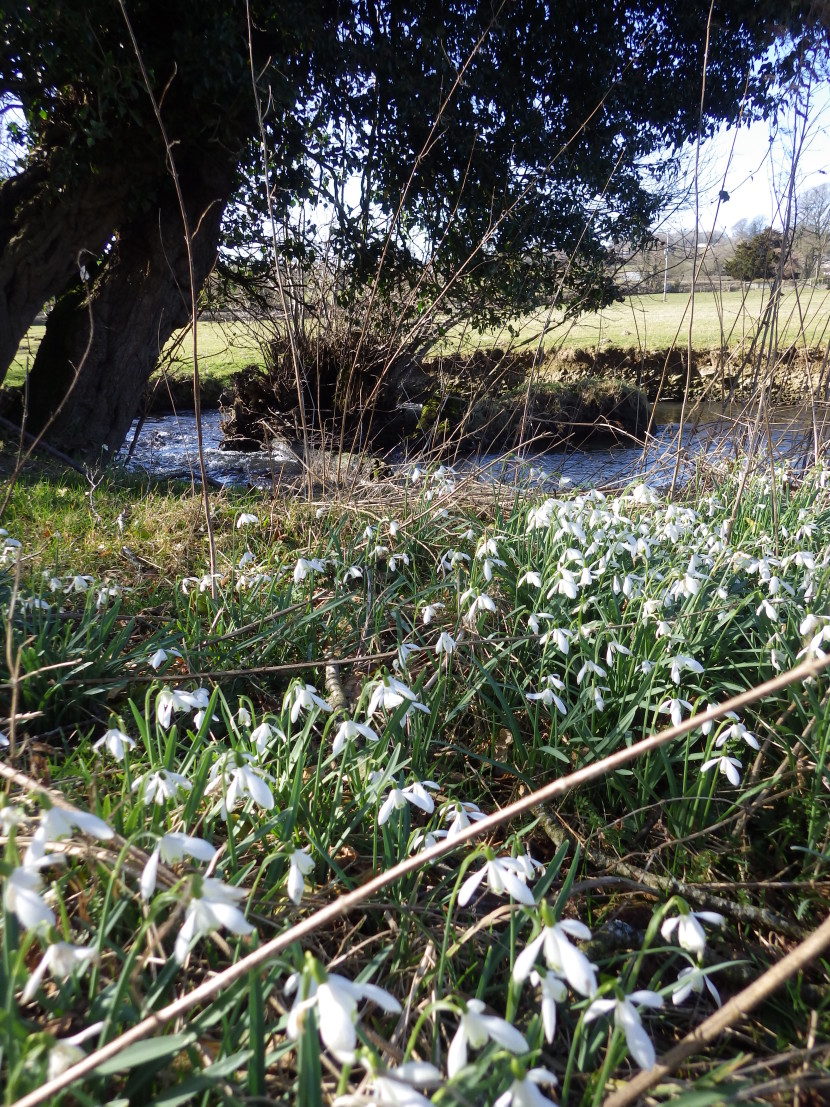
We entered February with some windy and mild days. With not only snowdrops but also daffodils already out nodding their heads, the real spring did not seem too far away. Rivers were falling slowly after the winter’s rain, but still high, and so fishing results remained modest. GP from Chatham made his way up to the top of the Irfon at Melyn Cildu, but found his way from the lower parking place by Melyn Barn down to the river blocked by new wire fences. Instead he had to move a mile to the upper parking place and try again. Maybe this subject of access could be clarified by the owner? I enjoy fishing Melyn Cildu, but there are a lot of fences without stiles here so that you must resort to dodging back and forth across the river – which you don’t want to be doing at this time of the year when there is a possibility of salmon redds in the gravel. AS from Wallingford with a friend were also confused by access problems at Melyn Cildu. In their case, by fishing dawn to dusk in a drizzle, the two of them managed 5 grayling to 1 pound 10 ounces.
On the 2nd SR from Llangynidr with a friend made a bag of 16 grayling by trotting at Abernant with 2ft of water on the Llanstephan gauge. That was a good choice of method and venue, given the water height. DM from Wells had a barbel of 8 pounds and 3 chub to 5 pounds at Middle Hill Court while GB from Bristol caught 3 barbel to 9 pounds at How Caple Court. IP from Staines had a great day trotting the Lugg at Lyepole, taking 13 grayling to 14 inches. On the 5th PT from Kidderminster had a difficult day trotting a float at Eyton due to high winds, but took 6 grayling to 1 pounds 14 ounces. Down at the lower end of the main Wye, AH from North Leigh caught 6 chub from Middle Hill court, along with a 10 pound pike which attacked the meat bait as it was reeled in. IS from Gloucester was back at How Caple Court on the 9th and caught a chub and 3 barbel, all during a brief midday spell of feeding.
That was all for a while as heavy rains brought rivers back into high flood. The temperatures overall had remained relatively high which probably accounts for the number of barbel still being caught as the winter ended. Barbel usually cease to take once a spell of frost is properly established, even if chub and grayling are still active. By the weekend the rivers were out over the fields again. GM from Shrewsbury had a couple of grayling from the top of the Wye at Clochfaen; otherwise there were no catches reported. I had a lunch table booked at the Hope and Anchor at Ross, only to find the car park under water. We parked uphill but ate well, with a view of racing water and debris under the sill of the dining room window. Anglers continued to try to catch the barbel and chub. GL from Abergavenny had 4 chub at Foy Bridge on the 14th. He had 8 more on the 18th. GP from Basildon caught 3 barbel at the Creel and was visited by a red squirrel. CM from Keynsham with a friend had 3 barbel each at Middle Hill Court, together with a couple of chub. The Ross gauge was at 2.6 metres, which to put it into perspective would be 2 metres above my preferred salmon fishing height. TD from Chelmsford with a friend caught 8 barbel to 7 pounds from a rising river at Fownhope 5 on the 22nd. JC from Reading with a friend matched that with 8 barbel from Middle Hill Court, remarking that the water was very high but the temperature was 10 degrees. On the 25th TW from Leominster with a friend caught 4 pike at Whitney Court. Incidentally a cod of 30 pounds 7 ounces was caught from a Bristol Channel shore mark during February, although the exact location is apparently not to be revealed. Cod run up to 100 pounds in the icy depths off Norway, but that is a remarkable fish from a British beach.
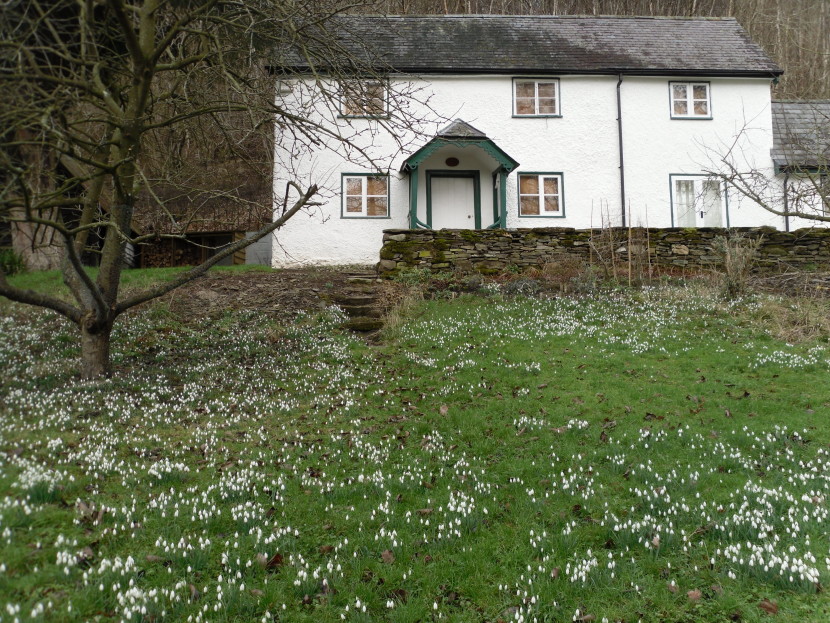 The cottage by the Lugg at Lyepole - spring is on the way
The cottage by the Lugg at Lyepole - spring is on the way 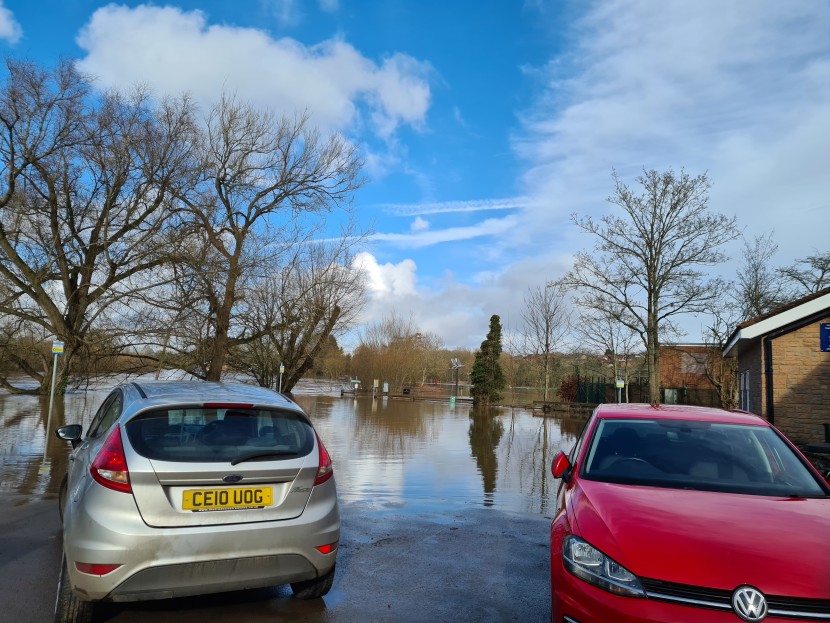 Hope and Anchor car park
Hope and Anchor car park By the end of February there had been a couple of frosty mornings and we had more showers, but the sun when it came had some warmth to it and the midday air temperatures were often in double figures. We saw frogs spawning in one of the beaver pools up in the Forest. Snowdrops and daffodils had been joined by primroses on grassy banks and bursts of white blackthorn blossom lit up hedges which were already turning green close to sea level. Rivers were still high, but dropping steadily. Several of the WUF water gauges were casualties of the winter floods, so that it was necessary to rely on the EA gauges for now
Winter’s end and the beginning of spring should be a time for anglers to take stock and then to go on to plan a strategy for the new trout and salmon seasons. I have to conclude that this was one of the most disappointing grayling seasons I can remember. I have concerns about our grayling stocks, although the high water and lack of wading access for weeks on end must account for much. I got out a couple of times with the trotting rod, mostly fishing from the bank, but that was all. Otherwise I was restricted to fishing our Forest Pool and I went shooting a fair bit. Our area received roughly double its expected ration of winter rainfall this year and in the circumstances the success of spawning salmon and trout will remain a mystery for a while. Even if the weather was cold enough to trigger ideal spawning – in itself quite doubtful – it is difficult to spot mating salmon or redds through extra metres of muddy flood water. Gravel will surely have moved in the pools, effectively forming an egg grinding mill as it does so.
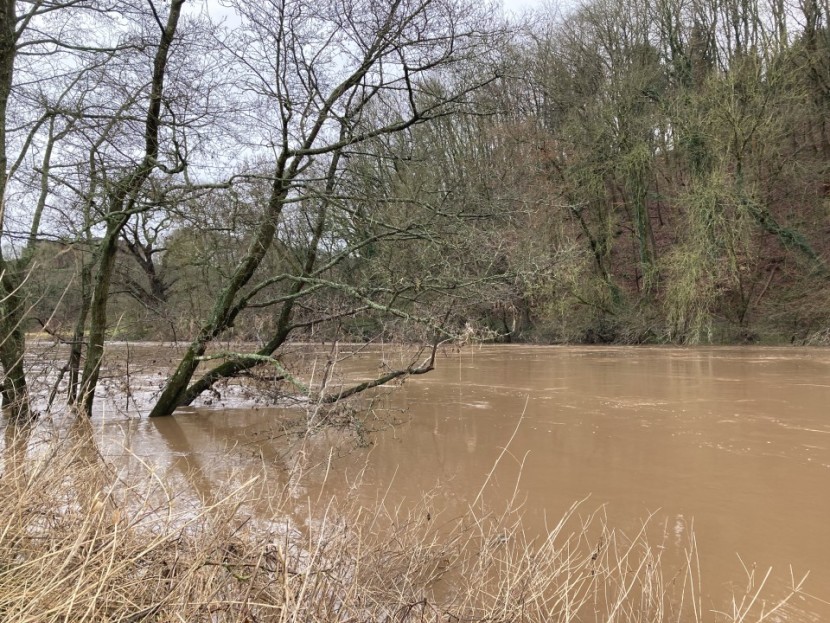 Flood fishing - BA from Epsom
Flood fishing - BA from Epsom 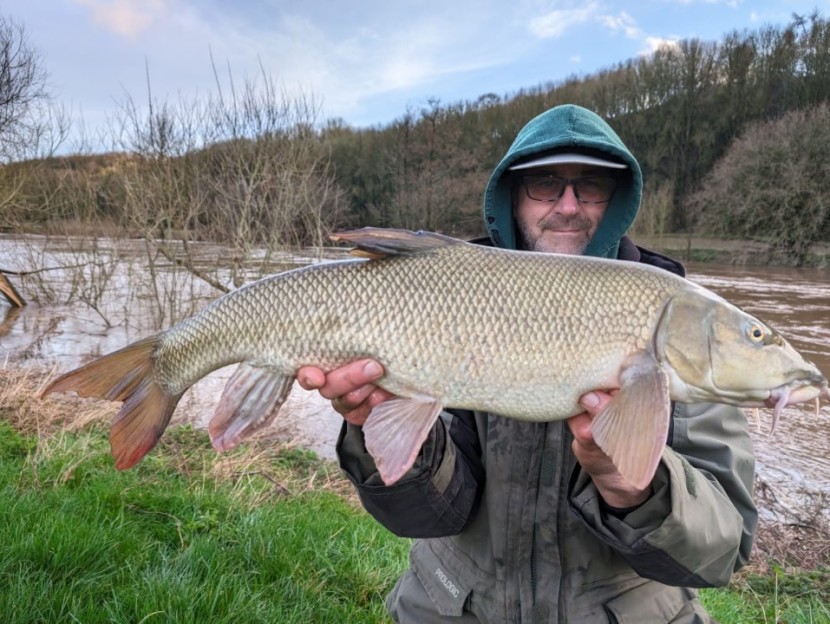 Middle Hill Court - BA from Epsom
Middle Hill Court - BA from Epsom So, where to go as a new trout and salmon season begins? For salmon anglers, the Wye will be the place to start this spring, as it is consistently an earlier running river than the Usk. March may seem too soon and numbers of fresh salmon in the river will certainly be low so early in the season. However, it’s still the case that wonderful three sea winter fish are occasionally caught this month. Fishing in March is admittedly be an act of faith, but the prize might be remarkable. I wouldn’t expect kelts this time as we have had so much high water recently to run the spent fish out to sea. Normally salmon anglers fishing early will concentrate on the middle and lower sections, but there has been so much high water all through the winter that it would seem reasonable to bet that a few springers have run high up and the first to be caught might come from the upper river. Expect an increased number of fish to be in the river as April goes on.
For trout the situation is reversed and the main stem of the Usk is the place to start in March. The upper Wye should join it a few weeks later. The Usk still has spring fly hatches, praise the Lord, and you need to be on the river and ready for them by the middle part of the day! You might not see anything until 11 o’clock, but after that until well into the afternoon you might encounter large dark olives (or spring olives as we used to know them), March browns and, given sunny weather and a bit of luck, some grannom sedge. It’s usually too much to expect extended hatches through the day, so if you see duns coming off the river and rising fish, don’t waste time but go right at them, even it means skipping lunch. For the Usk in March I will be using dry flies or a team of North Country spiders.
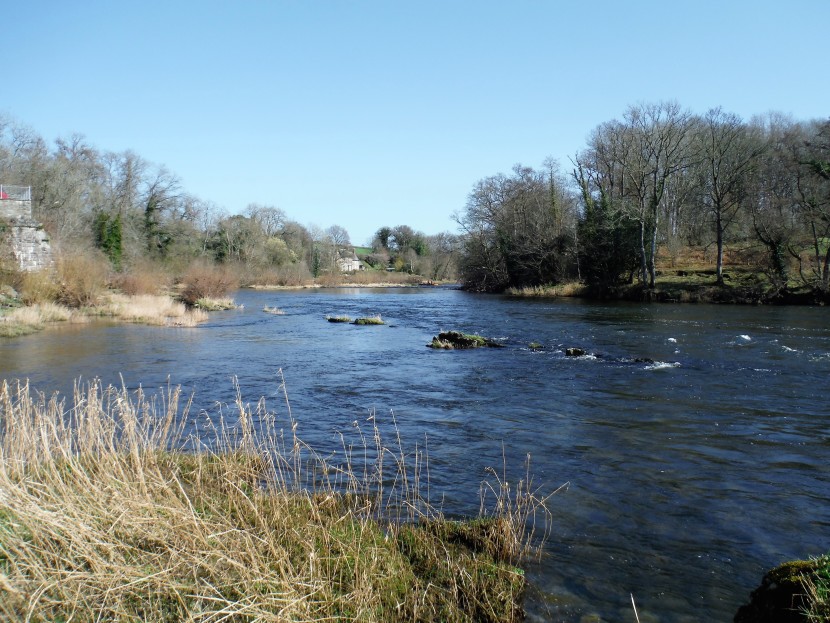 The upper Wye's Mill and Rectory Neck Pools in March
The upper Wye's Mill and Rectory Neck Pools in March 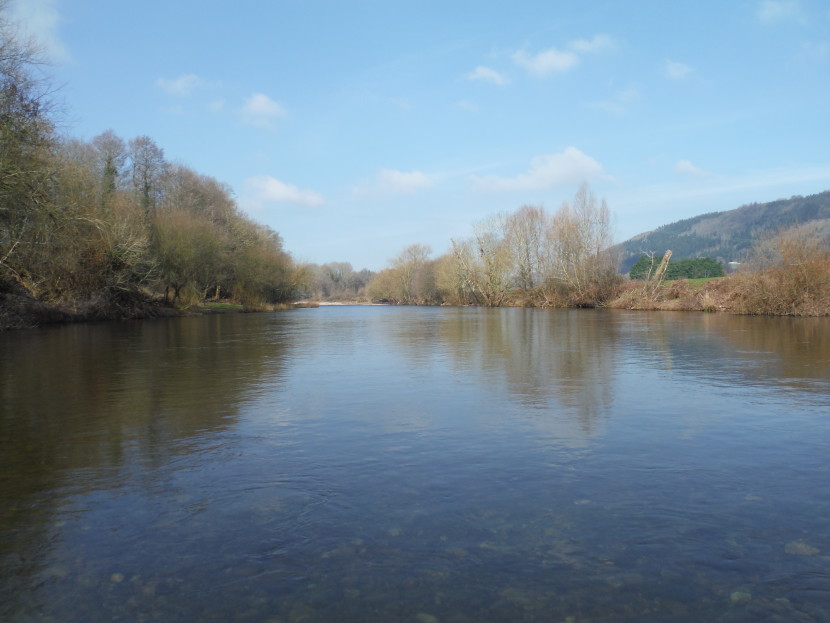 Peter's Pool on the Usk - early spring
Peter's Pool on the Usk - early spring Sport on the tributaries and particularly the upper tributaries at the top end should gradually add to the fun as the spring warms up. This particularly applies to the Wild Streams, where you might well need to use a nymph until we get into April and fish start to come to the surface. If in doubt when making a decision about choosing brook fishing in spring, go by altitude. Generally the higher the stream, the later in the year the action can be expected on the surface. My local Forest of Dean streams, although they are relatively early and close to sea level, usually don’t come into their own until March is out.
This winter some of the coarse fishermen, mostly visitors to our region, did wonderfully well on the Wye despite the floods and in warm conditions the co-operative barbel kept feeding all the way through. Coarse fishermen, I suppose, will take some time off after 15th March or perhaps go to fish in lakes. Why not do some fly-fishing as well? In my youth, fly-fishing for my particular group of pals began as something to do during the coarse closed season, but then became more and more addictive. Reservoirs came first, followed by rivers. I was lucky enough to experience some West Country moorland fishing in those far off days and I have particularly happy memories of Exmoor.
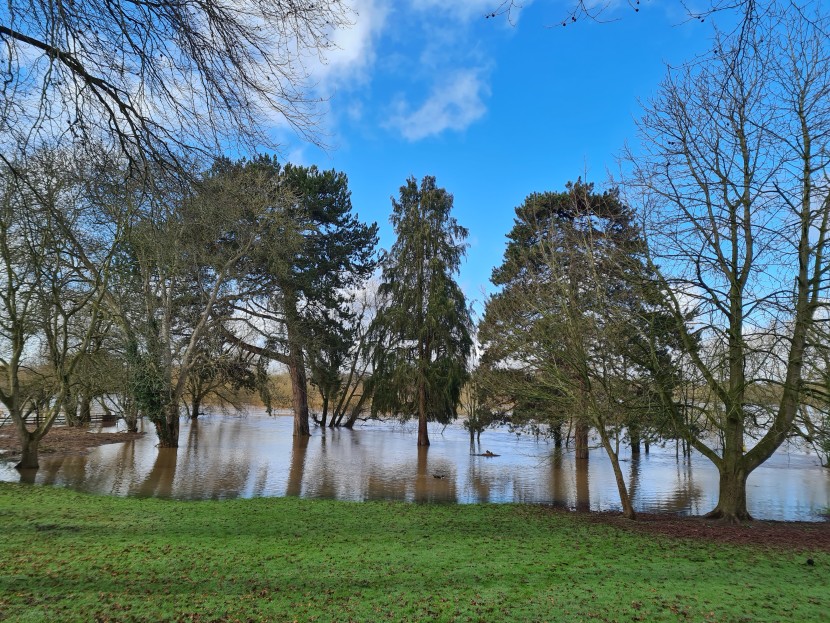 Floods at Ross
Floods at Ross 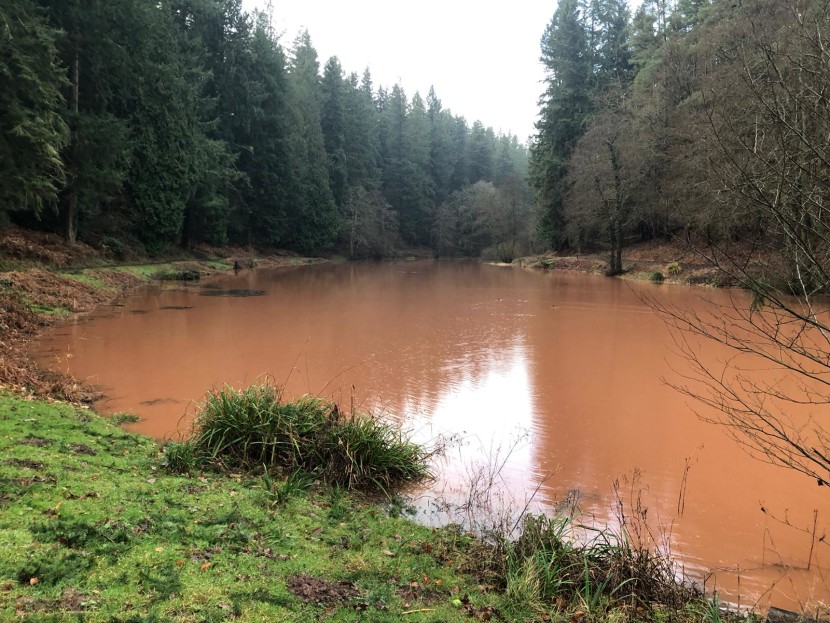 Forest Pool coloured
Forest Pool coloured The March 2024 edition of Fly Fishing and Fly Tying contains an article entitled A Tale of Two Rivers by Dr Cyril Bennett MBE. Over recent years, every time I pick up an angling magazine or often enough now the mainstream press, I have got quite used to reading yet another expose of the damaged state of our rivers, whether because of sewage pollution or excess phosphate deposition, or from various other man-made causes. We are all familiar with these articles; we understand the situation perfectly well, sometimes there are fines at the end of the story, but rarely is there any concrete example of steps taken to permanently rectify the damage. It’s difficult to call attention to yet another angling writer’s cry from the heart when so little appears to result from publishing already well known facts. However, this article caught my eye, mainly because it is about two rivers I know, one of them quite well – the Wey of Surrey and Hampshire, and the Avon of Wiltshire and Hampshire. The Wey may not be so very famous a trout stream, but in my youth I caught most of my early fish from it along with some grayling too, so I have a soft spot for it. I was very proud to discover that it was from the Wey and the Itchen that the first European brown trout were taken to stock the rivers of New Zealand. The Avon has always been famous for its trout fishing and now I am lucky enough to be invited to fish the Upper Avon on Salisbury Plain several times a year.
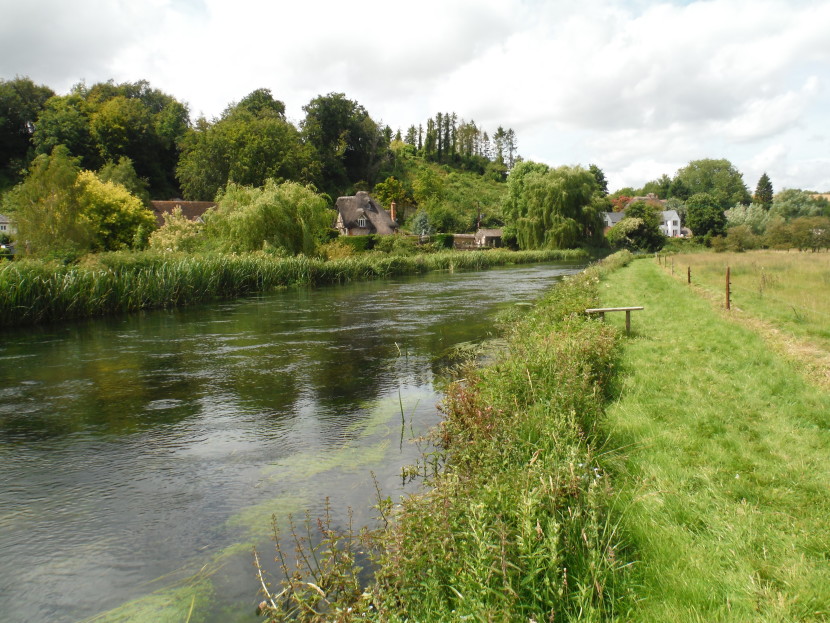 Avon valley
Avon valley 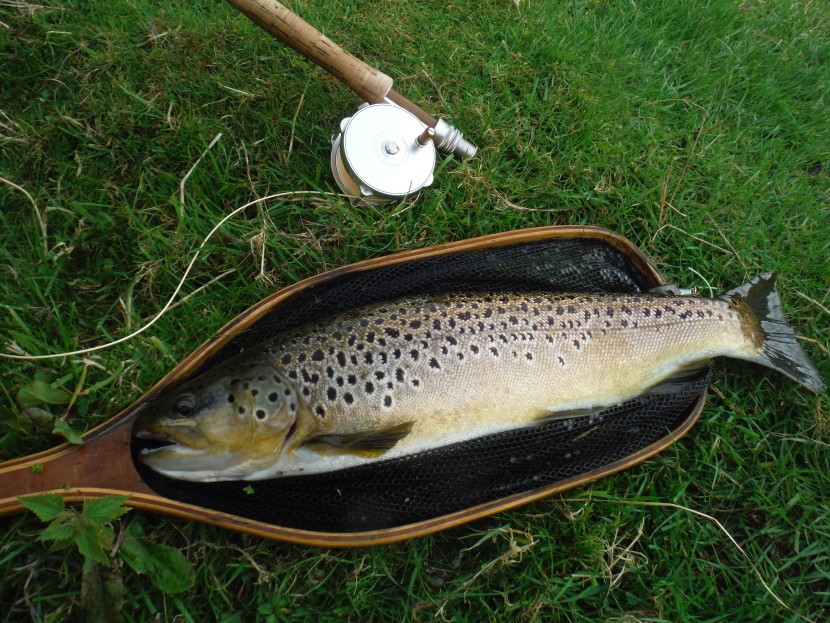 Avon trout
Avon trout Dr Bennett also describes these two rivers as those he knows best. He made himself famous by a very determined attempt to study and restore the population of upwinged flies, particularly mayflies, on the River Wey and took a PhD in entomology while he was at it. Much came out of his efforts. He was one of the founding members of the Anglers’ Monitoring Initiative which began 25 years ago on the Wey, a river which was damaged by abstraction and various pollutions. This association of volunteers is a very useful initiative, still growing, although it would benefit from a more user-friendly website. In those early days, a successful attempt was made to restore the fly life of the Wey using fly boards as developed by famous chalk stream keepers such as Sawyer and Lunn. Eggs of large dark olives, blue winged olives and true mayfly were transferred by this means to the damaged Wey. The source of fly for restocking during this operation was the Hampshire Avon, not too far away, a Special Area of Conservation and certainly with massive natural hatches present when eggs were still being collected for the Wey in 2016.
What shocked me about Dr Bennett’s article is that apparently in about half a dozen years the situation has been reversed. Judging by his graphs from 2022, the Wey population of flies including blue winged olives, large dark olives and yellow may duns is thriving. The egg transfer and the subsequent sample took place at Frensham. However, on the Wiltshire Avon (sample taken at Amesbury) the population has dropped right away during the same period. Total number of upwings using the same sampling methods at Amesbury favoured the Wey insect life over the Avon at 5,500/130. In the case of blue winged olives, the ratio favouring the Wey was 4,000/12. Frensham Flyfishers carried out the Wey sampling while Wiltshire Fisheries Association using the same methodology sampled the Avon.
The article raises questions in my mind as well as providing answers. Dr Bennett blames nutrient enrichment downstream of the Amesbury sewage treatment works for the decline in fly life in the Avon. David and I fish a few miles downstream of Amesbury at Heale House and have been doing so for the last half dozen years, roughly the time and not far from the place in which these dramatic changes have been recorded. I must admit we haven’t been doing kick-sampling during the relevant period and maybe we should. However, we have had some very good fishing over the last 6 years. From an angling point of view, I still look on this as a great dry fly water. I would say the mayfly has been holding up reasonably well, or at least it did so until this last summer which was admittedly disappointing and often led to the use of nymphs. I haven’t seen huge numbers of blue winged olives during my time fishing at Heale, but pale wateries are certainly significant on our reach for much of the season. The DEFRA/EA survey results published towards the end of the period for the Nine Mile Water (Amesbury and down) show overall good results, including for phosphate. Biological quality for both fish and invertebrates is rated good. It’s a subject to discuss with the keepers when we get down there in April.
On the adjoining page of the same magazine is an article by Andrew Griffiths about pollution of the Wye. He writes, to begin with, as though expecting to be greeted with a collective yawn. As stated above, given the years of advocacy work spent on this subject by numerous and dedicated actors, the WUF leading the way, we all know what the problems are: the high phosphate levels, injudicious spreading of slurry, sewage pollution and the rest. The defects in human management of this fine river have been reiterated again and again. Natural England has redefined its status as “unfavourable, declining.” The question always seem to be, as the years go past and as we wring our hands impotently: “Will anything ever be done?” It’s difficult to write about a problem when faced with such apparent inertia. All we seem to get from government and the government agencies tasked with protecting our environment have been soft reassuring words, platitudes and broken promises. There has been talk over the years about a voluntary and consensual approach being more effective when dealing with potential or actual polluters. Meanwhile there’s a new range of 50p coins coming out, one of which depicts an Atlantic salmon. How nice! Lately I’ve been wondering if the day may come when the last salmon I get to see will be on a coin.
However, Mr Griffiths points out that there is a new approach being used right now which might just prove more effective. This is the idea of suing the regulators directly for failing to do their job. In the case of the Wye, the fact that it crosses the English/Welsh border has been catered for. Thus, River Action has achieved a Judicial Review hearing this month in which it will claim that the EA and DEFRA have acted unlawfully in failing to protect the English Wye from agricultural pollution. Simultaneously Fish Legal has submitted a legal complaint against Natural Resources Wales alleging that NRW has failed in its statutory responsibility to protect the Wye from agricultural pollution. Fish Legal has had some success with this approach elsewhere, although I suppose much will depend on the attitude of judges. Am I the only one who now feels the hell with the consensual approach; let’s try the stick?
Some of the clients who come out with me have either never fished before, or at least have never fly-fished before. I get a lot of pleasure thinking of the number of people, both young and old, I must have taught to cast over the years. At the end of the first day, I aim as a minimum to have beginners making a decent overhead cast over either shoulder along with side casts and a competent roll cast. After that, clients may not be fishing every day and some of them may never be able to do much more than get a respectable line out, but hopefully the basics will be established and the sport will sooner or later take a proper hold on them. Fly-fishing is one of those activities which can be laid aside for a period if the needs of the world combine to claim all your time, but it’s pretty rare to find someone who has given it up altogether. In recent years, I would say that virtually every one of those newcomers to the sport has remarked to me on how much they enjoyed the Mortimer and Whitehouse: Gone Fishing television series and how much it made them want to try it for themselves.
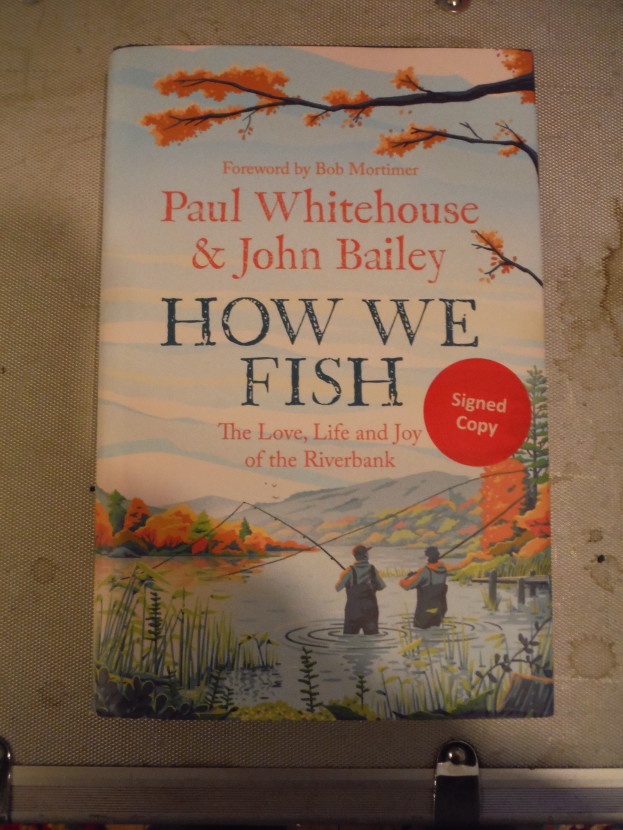 How We Fish
How We Fish I enjoyed Gone Fishing too, for reasons which would have surprised everybody before the series was made. For a start, it’s not so very much about fly fishing or even fishing, at least not in a technical sense. It certainly began in the first series by portraying two middle-aged men who have had some serious health problems. They have both been successful in high stress jobs; now there is a sense of being lucky survivors, and of wanting to focus now for a period on what they really enjoy in life. That fits with everybody’s experience; I don’t know anybody who fishes who doesn’t rate the fishing hours in their life pretty highly. They are both very funny, as you would expect renowned comedians to be, and what seem to be their meandering ad-libbed conversations on the bank are a delight. They talk about their lives, their families, the girls they first kissed and a fair bit of nonsense. Even more of a delight is that you begin to realise that Paul Whitehouse is a sort of OK fisherman and knows a bit about what he is doing, but Bob Mortimer clearly never will be. Either that, or Mr Mortimer puts on a very good act. But oh how he loves the sport! His excitement when attached to a fish is a sight to behold. In addition, the photography is gorgeous and often the fishing takes place on Usk, Wye, Severn and other rivers known to us. There is a bit of cooking, always popular, and some glamping-style accommodation to add colour. And incidentally there is no false modesty about who these enthusiastic anglers are: a couple of successful guys with quite a few quid to spend as the smart cars and top range waders make clear. Every so often a professional fisherman of some kind comes into the picture, but, wisely I think, the director keeps such figures in the background and concentrates on the main protagonists. Shooting time with a film crew costs money, so of course there is an angling adviser to help set up and plan the different episodes to get the best results. That is a high pressure job if there ever was one, and in this case it is filled by the well-known angling presenter John Bailey, formerly based in Norfolk and now living in the Wye valley.
There is a book which goes with the series and which somebody gave me a few years ago. This Christmas my son gave me another one: How We Fish by Paul Whitehouse and John Bailey the above-mentioned angling adviser. When I started reading it, I thought it might be like the previous book, mainly light-hearted humour and very much in the vein of the TV series. However, not quite so. There is plenty of humour, of course, but the book gives a wide-ranging view of the approach taken over the years by two experienced anglers. This approach is an interesting one, sensible, but not highly technical and specialised as is so often the case these days. What I like about these two is that they choose to be angling all-rounders rather than specialists. Paul has an understandable liking for salmon fishing, but can work up just as much enthusiasm on a day after barbel or pike. John has a background in specimen hunting, but is willing to discuss grayling and trout as well as big roach or bream. They admit that their methods would be regarded as “old school.” They certainly know about bolt-rigs and boilies, but are not tremendously enthusiastic about these new-fangled methods. They try to travel light without carrying too much kit. Instead more is made of walking the river, spotting and stalking fish, free-lining baits, touch ledgering, the two basic types of floats, laying on and even stret-pegging. There are practical suggestions here which would have been perfectly familiar to Francis Francis or Bernard Venable’s Mr Crabtree, and why not? The book is perhaps light on game fishing, but there is some good information here about both fly-fishing and spinning. There is also some sea fishing and they have something to say about almost every species, including grey mullet, a subject on which they are at least honest: “Why, oh bloody why, can’t we catch them?” (More about mullet on another occasion).
I take issue with some remarks or assumptions about so-called highly educated fish. Our quarry have brains about the same size as that of a frog, and I firmly believe that even the big ones make mistakes. I am sure Mr Bob Wyatt down in New Zealand would have something to say about that. Once there was a myth that large carp were so intelligent as to be virtually uncatchable, but that certainly is not true. However, I suppose I may well find myself on a summer evening later this year trying to persuade a steady-sipping Usk trout to eat some kind of blue winged olive spinner imitation and come to regret these words. Taken altogether I would recommend this book as a good read for anybody and particularly good advice for a beginner.
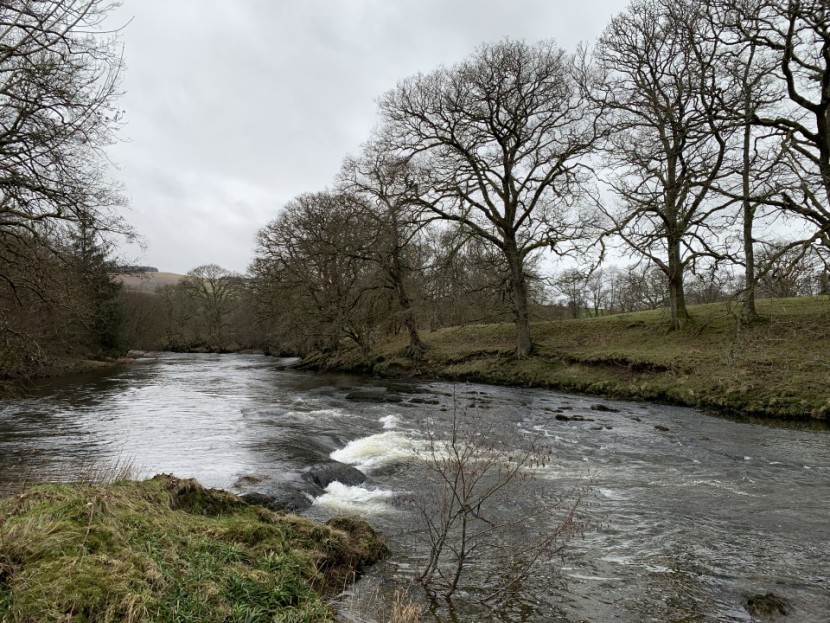 Cefnllysgwynne - AC from Nailsea
Cefnllysgwynne - AC from Nailsea 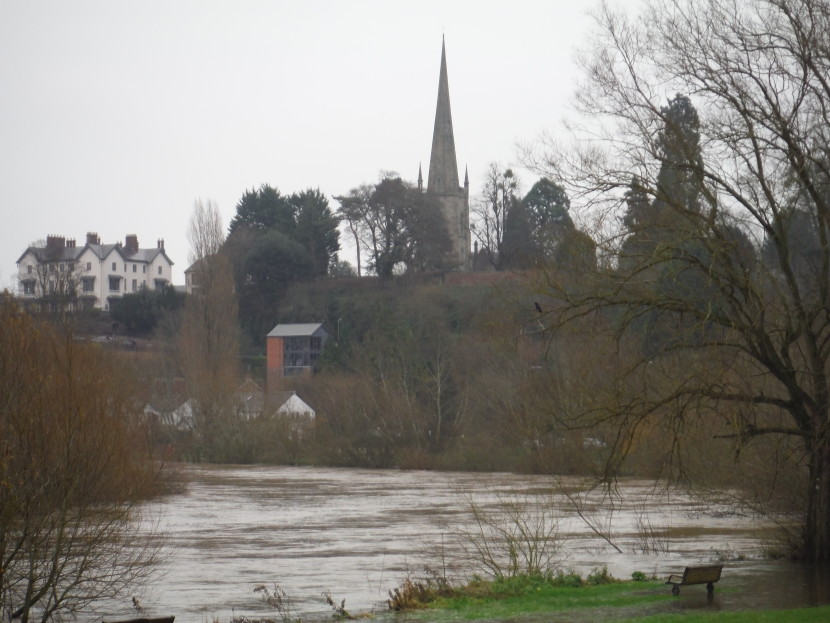 Ross on Wye
Ross on Wye My Welsh friends and I have been discussing the new 20 mph limits now applied to many roads in the principality. Driving does not seem to be the pleasure it once was and the limits are far from popular. Within the first few days I was amazed at how much time was being added to routine journeys. This was not purely due to the 20 mph limits on suburban roads but the 50 mph limits which have also suddenly and inexplicably appeared on dual carriageways. These include the westbound M48 from Chepstow to the junction with the M4, the dual carriageways from Usk to both Monmouth and Abergavenny, and more. None of these seem related to any roadworks. At any rate and it may be a coincidence, journeys to which I used to assign 1.5 hours have stretched to 1.75 or 2. The other change I have noticed is that many frustrated drivers, as soon as they reach the National Speed Limits sign and leave the 20 mph zone, make a point of slamming open the throttle and go screaming off through the gears as if taking part in the first lap of a grand prix. The new necessity to dawdle along on roads which may have no traffic or pedestrians present is creating palpable irritation and tension.
We have now come to a conclusion, my Welsh friends and I. We have already heard the local government is determined to build no new roads in Wales. A declaration of breath-taking arrogance you might consider? However, I’m thinking that I will put up with that if only they will get on and finish the Heads of the Valleys dualling works which in our minds have come to exemplify like Purgatory? Traffic in South Wales is already chaotic enough. The constant closing of the M4 at night has been another bone of contention for sea trout fishers. I have seen quite enough of the inside of Swansea town and Newport dock diversions in the early hours while trying to find my way back onto the motorway. Otherwise, if the administration in Cardiff really believe that 20mph limits will save lives, we expect they will soon be busy putting in sleeping policemen and other traffic calming methods on the roads concerned, plus a generous helping of those helpful electric signs warning drivers of their speed as they approach the restricted zone. Both these measures should avoid speeding due to inattention and thus, if you believe the theory, save life and limb. We would all be grateful for that I am sure. If, on the other hand, the authorities in Cardiff are really only concerned to harass and discourage motorists and raise funds for their leaking budgets by levying fines, they should go right ahead, put up the signs and do no more than get ready with the concealed cameras. I wonder which of these two policies we will see enacted as time goes by. How motoring in Wales has changed! When I was a young man, the A-roads of Central Wales with their long sweeping bends were a delight for motorcyclists playing tunes on close ratio gearboxes, as were the “Green Lanes” in the mountains which could legally be driven or ridden using off-road 4WDs or trials specification motor cycles.
Meanwhile in England the bicycle now reigns supreme with the help of the Greens. A few years ago in our little Severnside town, one of the councillors, a non-driving gentleman who rides a bicycle, persuaded the rest of the council to apply to central government for a grant to make the town cycle friendly. He used that time-honoured and compelling argument “…if we don’t grab the money, somebody else will,” and so around a million pounds was secured. During the following summer, a gang of men worked away widening the pedestrian walkways on the roads leading into and out of town, painting out the white lines in the middle of the road which drivers use as a datum point to keep in line, and painting a series of new and confusing white lines defining cycle ways at the side, thus pushing motor traffic to the centre. At once there were several near-accidents as disoriented drivers found themselves approaching each other head on.
Now as everybody knows mountain biking up in the Forest of Dean is very popular, particularly on the old railway tracks which make their way through the wooded valleys. There are cycle rental and repair companies in several locations. However, this off road sport is for enthusiasts and visitors, who keep to the Forest and rarely show up in our streets. In fact my friend the taxi driver, who is in a position to know, tells me that there are just six cyclists in our town. One is the above mentioned cycling councillor. Another is the ginger bearded tramp who lives in a tent in nearby woods, and who cycles in very early in the morning to pick up food from the supermarket and cooking gas canisters from the hardware shop. He is a harmless fellow, but he avoids his fellow man. The other four are factory workers who use their bikes to ride to jobs on the industrial estate down at the port. Like our teenagers, for some reason they cycle on the pavement rather than the road. Oddly enough, the skate boarding teenagers prefer to use the road. Now the theoretical cycle lanes are marked but the roads are full of potholes. All in all, the new cycle lanes seem like a waste of money and it’s rare to see a cyclist on them. But here’s the thing these days: bicycles are good, cars are bad. You have to remember that.
At the same time we do have problems with traffic on our rural high street. This is partly because of the unduly long and roundabout bypass built a few years ago which leads many motorists, including heavy truck drivers, to skip the extra mileage and come straight through the middle of town just as they always did when this was the main road to South Wales. Also, and despite local objections, more and more new houses are being built on the outskirts, turning a small country town into a large dormitory town. The new owners will be working in Gloucester or Newport, because there is nothing much here. Meanwhile the local convention that it’s acceptable to park on a yellow line if you are buying a takeaway doesn’t help the traffic. If an inexperienced young policeman tries to query that practice with a Forester, he is likely to hear no more than the tendered explanation: “Wot? Kebab me old butt. Bist tha new round ere then?” Good luck with writing that ticket. Our Forester friends are rather prone to appropriating special status for themselves as “indigenous inhabitants” in the manner of First Nations in the New World and they certainly don’t like being told where to park. Now if I had a million quid to spend on traffic measures for our high street, I would have used it on mini-roundabouts to relieve choke point junctions: one on the Tesco entrance, one on the road to Bream, one on the Forest road and one on the road to Yorkley. But as usual nobody asked me!
Meanwhile some of us await the advent of compulsory electric cars for all with a kind of disbelieving gloom. The other day a client was asking me if I knew of good grayling fishing closer to the Midlands than the upper Wye. The reason was that his company had given him an electric car and he didn’t think it would make the round trip to Erwood. I suggested the Herefordshire Lugg. On the other hand, two clients turned up at Builth recently in a very sleek looking Tesla which had been acquired second hand. They assured me that it had a reliable range of 280 miles and would accept a fast charge in 20 minutes. They were certainly enjoying driving it. Unfortunately I can’t afford a Tesla.
Does all this sound very self-centred and bitter? Don’t misunderstand me; I do believe in the phenomenon of climate change and I am open to taking some carefully measured decisions over time which will lead to reduced carbon emissions. It’s just that I don’t want to destroy our economy in the process and I’m not a fan of lemming-like dead-lines that the rest of the world is not going to follow.
That’s the end of my rant about road transport in our beautiful countryside! Forgive me for the bad mood; I have just experienced that painful moment of paying my tax bill, secure of course in the knowledge that those who govern us will spend it wisely! Tight lines for the new season!
Oliver Burch